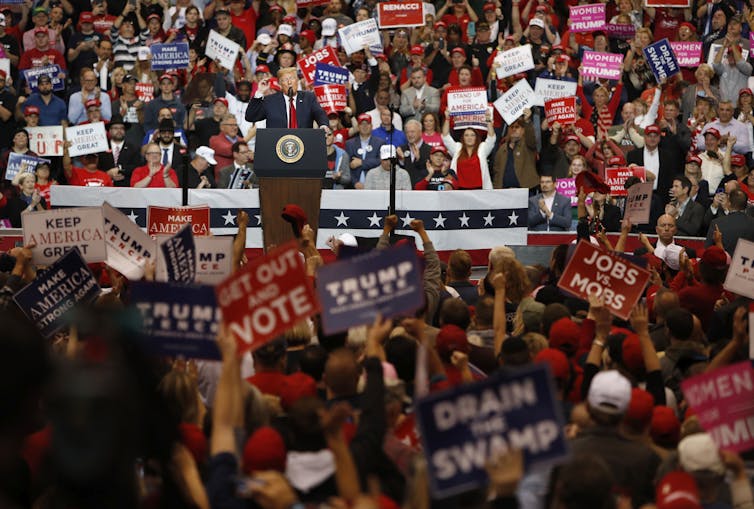The battle to oppose Donald Trump in 2020 has begun. A large field of Democrats has embarked on the complex strategic game of choosing policies and styles as each candidate strives to win attention in a crowded field. Over all of these looms the incumbent.
Elections between an incumbent and a challenger often focus on the record of the current president. In this cycle, each candidate for the Democratic presidential nomination must work out how they will handle the presence and record of Trump, crafting their attacks on him as they strive to persuade voters that they are the right candidate to beat him in November 2020. Those strategies are already emerging with a plethora of direct attacks on Trump’s policies and style and indirect attacks represented by proposals for a more optimistic, idealistic and less partisan politics.
Underpinning all of these arguments will be an assumption that Trump has changed the US during his presidency. The Trump record is already being portrayed as one of radical and – by Democrats at least – dangerous change. On June 26, in the first of two televised debates between the main Democratic candidates, Governor Jay Inslee of Washington even named Trump “the biggest threat to the security of the United States”.
The Democratic candidates have good reason to demonise every aspect of Trump and his presidency, pursuing support by reflecting their fellow partisans’ antipathy to the Republican Party and the president. There is even the potential for candidates to compete during the primaries to look more anti-Trump than their rivals, as demonstrated throughout the two debates.

Yet, by attacking Trump for the changes he has brought, the candidates are deciding to fight the 2020 battle on Trump’s chosen turf, accepting that he has been an agent of change. Both Trump’s rhetoric and media commentary on his 2016 campaign defined the “Trump phenomenon” in terms of the changes he would bring. He portrayed himself as the outsider, coming to Washington from his business career and as a disruptor who would change the governmental order. He would arrive as a populist tribune of the people, challenging the elites with a Trump insurgency. Trump’s hyperbole and commentators’ reaction to him suggested that revolution was at hand.
An ordinary presidency
Yet that basic claim, that Trump has brought dramatic change, is a wholly unrealistic assessment of his successes and failures during the first part of his presidency. As we outline in our recent book, The Ordinary Presidency of Donald J. Trump, there is no Trump revolution.
Instead, we argue that Trump’s presidency should be considered ordinary – both in terms of the both the paucity of his policy achievements and the absence of radical thought guiding the policy achievements he has delivered. Trump has not achieved very much – and when he has it is standard Republican fare.
Trump can only point to a small group of significant legislative victories. His tax cuts, passed at the end of 2017, were clearly substantive. Despite the president’s claims, they are nowhere near the largest tax cuts passed in history – according to an assessment by the Committee for a Responsible Federal Budget – but nevertheless they represent a significant legislative achievement which may have assisted economic growth in the short-term and may contribute to a long-term legacy of federal debt.
Trump also secured the nomination of two conservative justices to the Supreme Court and substantial numbers of lower court appointments. The US may still feel the impact of these choices in two or three decades. These achievements represent the limited level of success typical of recent presidencies. And any Republican winning office in 2016 was likely to pursue these goals.

Whither Trump’s radical agenda
Where Trump advanced radical policy proposals, he failed. When the brash outsider proposed healthcare reform he endured ignominious defeat, even if he was later able to dismantle parts of Obamacare. Executive action on the immigration agenda has earned much attention, but a Democrat successor could reverse many of these policies within hours of entering office. Trump has proposed comprehensive immigration reform to Congress twice, and is in the process of being rebuffed a second time.
The government shutdown at the turn of 2019 merely served to emphasise how little progress Trump has made in attaining funding for a wall on the US-Mexican border. His pledge to drain “the swamp” has turned from a revolutionary attack on the way politics is conducted in Washington to an utterly conventional Republican attack on federal agency budgets and regulations with the usual mixed results.
The protectionist wall that was to revive US manufacturing amounts not to an assault on the international trade system, but to a businessman’s play for greater political leverage to eke out marginally improved deals with trading partners. The shift from the North American Free Trade Agreement to the US-Mexico-Canada Agreement, if Trump can confound his legislative record and win its passage through the Senate, is at most a limited evolution given the similarities between the agreements.
Trump has used tariffs, among other devices, to act against China, but there is little sign that China has recognised any strategic need to change its economic policies in the direction the president would like. When offering radical proposals, Trump has not won over his own party and so, largely, he has only been able to achieve what his party will tolerate.
Trump’s personal style – vocal, expertise-averse, scandal-prone and driven by a focus on his partisan base – may be unusual, but aspiring Democratic presidential contenders may be making a serious error in allowing Trump’s “Wizard of Oz” act of big claims and small achievements to pass unchallenged. There is a massive gap between the pledges he made to voters and the reality of an outsider presidency thoroughly co-opted by its party. So far, the “Trump revolution” turns out to be an ordinary Republican presidency.

